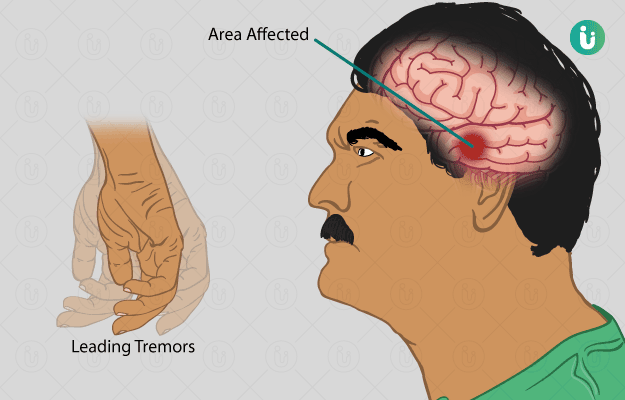What is Parkinson’s disease?
Parkinson’s disease is a neurological condition which leads to progressive brain damage by affecting the neurons (nerve cells). These are responsible for transmitting signals across the brain through a neurotransmitter called dopamine. Under normal conditions, a smooth, balanced muscle coordination is achieved with the help of dopamine. It is the lack of this neurotransmitter that results in the symptoms of Parkinson’s disease.
What are its main signs and symptoms?
One of the early and most common symptoms of Parkinson’s disease is tremors felt on one part of the body, either the hands or feet or even in the jaw. The tremor or shaking is usually noticed when the hand is resting, typically seen as a movement of the thumb against the index finger.
The second symptom usually noticed is muscle stiffness. There is uncontrolled muscular stiffness restricting free movements. These individuals show a gradual reduction in the speed of any activity. Simple activities like bathing or eating can take unusually long to finish.
Symptoms occurring in the later stages of disease include loss of balance, depression, a masked expression on the face and a slouched posture.
Relatively infrequent symptoms include fear, drooling, skin issues, urinary problems and sexual dysfunction. The tremors significantly affect the speech and handwriting as well.
What are the main causes?
Although research to identify the probable causes is going on, it remains unknown. Genetic factors and certain environmental components are believed to be potential risk factors for Parkinsonism.
Gene mutations have also been identified as a risk factor in developing Parkinson’s disease, but the exact susceptibility is not clear.
Exposure to pesticides used in farming is a potential environmental risk factor that contributes to this disease. Other rare causes include individuals on certain antipsychotic drugs or those suffering from brain illnesses or people who suffered from a series of stroke attacks in the past.
How is it diagnosed and treated?
Diagnosing Parkinson’s disease can be tricky, as there is no specific blood or laboratory investigation to confirm the condition. Moreover, the symptoms often mimic other conditions like orthopaedic abnormalities or vitamin deficiencies.
Hence, an elaborate history along with a history of medications used in the past should be elicited correctly. A CT or MRI scan can be taken to visualise the overall effects on the brain. Consultation with a qualified neurologist is advised, who can monitor the symptoms over a period of time and keep a check disease progression.
As far as treatment is concerned, a variety of medications to supplement the lack of dopamine are available. They act by stimulating the affected brain areas. However, over a long term, these medications may show side effects.
If medications cannot control the symptoms, surgical options are considered. This is done by placing electrodes to stimulate the brain and, in turn, block impulses that lead to tremors.
Parkinson’s disease is a progressive disorder. There is no definite cure for this condition; however, aiming for mental wellbeing and maintaining physical activity should be the long-term goals for individuals living with the disease.

 Doctors for Parkinson's Disease
Doctors for Parkinson's Disease  OTC Medicines for Parkinson's Disease
OTC Medicines for Parkinson's Disease
 Parkinson's Disease articles
Parkinson's Disease articles News for Parkinson's Disease
News for Parkinson's Disease

 Diet for Parkinson's Disease
Diet for Parkinson's Disease









 Dt. Akanksha Mishra
Dt. Akanksha Mishra












